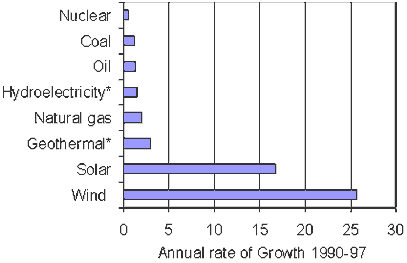- Enable countries to avoid taking politically awkward domestic measures to combat pollution, e.g. such as removing subsidies from fossil fuel electricity.
- Promote the establishment of sinks while diverting attention away from RE and energy efficiency (EE).
- Fail to deter investment in extensive new carbon-based resources and technologies.
- Create a 'blow out' in the AAUs of Annex 1 countries.
- There have been many debates regarding the setting of baselines, matched by the concern that baselines can be manipulated to exaggerate the reductions being achieved.
That having been said, the flexibility mechanisms should be supported in principle on the basis that they are more politically acceptable then other options. In due course, this could enable targets to be tightened faster than otherwise and bigger reductions to be achieved.
Flexibility: a 2-edged sword for RE
The flexibility mechanisms are a two-edged sword as far as RE is concerned. RE could benefit in the short term as this sector:
Advertisement
- will not have to purchase permits
- may experience increased demand for their products and services by those large CO2 emitting organizations that do have to purchase permits
- can create CDM credits and JI transfers
- will help set the price of carbon in international trading
- are part of the ultimate solution of creating a sustainable energy system.
In the short term, biomass projects may be the most attractive form of RE as it is currently one of the cheapest forms of RE and can be an adjunct to sequestration projects.
However, the early uptake of RE is not an assured outcome of the flexibility mechanisms as other options may be cheaper, easier or simply able to sell themselves better to prospective buyers. In Australia a critical compliment to the flexibility mechanisms is the provision of industry development policies and programs to ensure that a strong local RE sector is established. Otherwise, Australia may find in 2050 that it is just a small South Pacific customer in a global RE market that has been captured by the USA, Japan and Europe which are already cashing in on the 'boom' in RE growth.
Annual Growth Rate of various Energy sources (1990-97)

Design domestic emissions trading as if RE mattered
To this end, domestic emissions trading needs to be set up in a way that RE solutions are encouraged.
- Auction permits as the method of initial allocation
Advertisement
Auctioning makes RE (and other GHG reduction methods) relatively more cost-effective because beneficiaries of 'grandfathering' – allocating permits free to existing emitters – only need to purchase emissions permits that are additional to their allocation. Auctioning is also a de facto form of 'credit for early action' – those companies that reduce their emissions early are rewarded by having to purchase fewer permits once emissions trading is underway.
- Direct revenue from allocation of permits (assuming auctioning of permits in whole or part) to promotion of RE.
What happens to the revenue from sale of emissions permits is a critically important complement to any emissions-trading scheme. Within Australia, it has been proposed that some of the revenue from sale of emissions permits (estimated at $3billion / year at a permit price of $10/tonne of CO2) be applied to financial incentives for products and services that facilitate reduction of emissions by end-users.
Discuss in our Forums
See what other readers are saying about this article!
Click here to read & post comments.